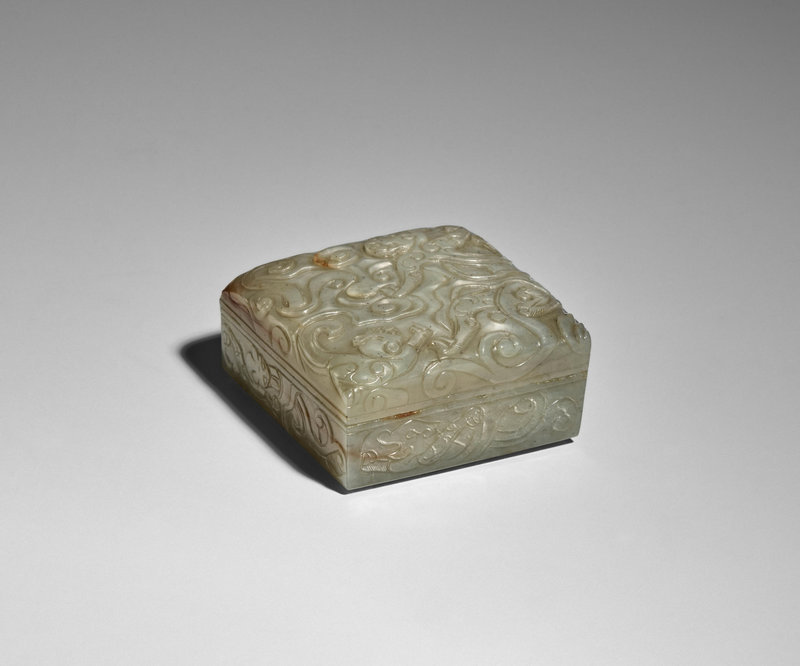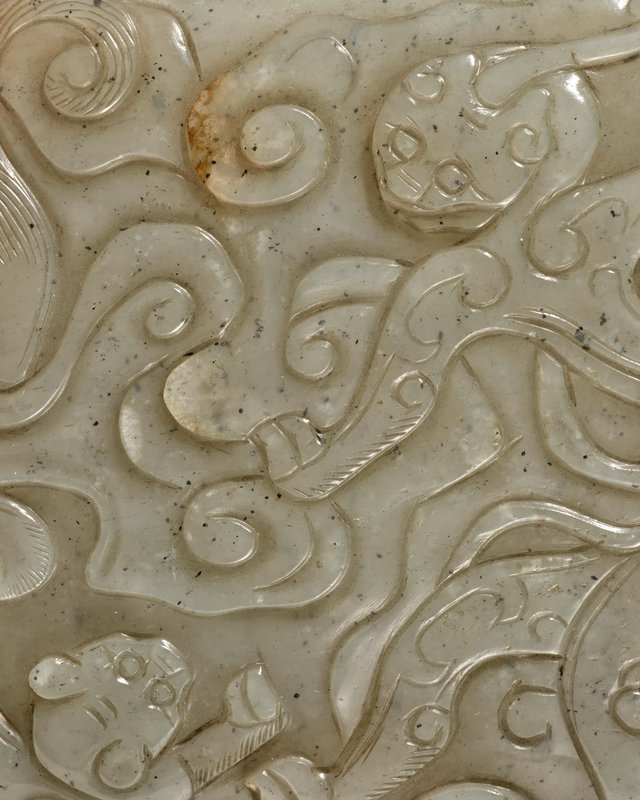Bonhams. J. J. Lally & Co. Fine Chinese Works of Art, New York, March 20, 2023
An archaistic jade dragon-in-clouds square box, Song-Ming dynasty
Lot 49. An archaistic jade dragon-in-clouds square box, Song-Ming dynasty; 7.1cm square; 3.8cm high. Sold for US$31,875 (Estimate US$15.000 - 20.000). © Bonhams 2001-2023
Carved in relief, two dragons above stylized clouds on the cover, the larger dragon with limbs stretching wide facing the smaller dragon at the diagonal corner, both dragons' wings and forked tails dipped to the sides, the box engraved with a dragon stretching horizontally on each side, the box and cover matched with a thin ridge at the rims and well-hollowed and polished on the interior, all supported by a shallow stepped foot enclosing a square indented base, the silvery-grey stone with scattered 'black pepper' spots and russet inclusions.
Provenance: From the Collection of Sackville George Pelham, 5th Earl of Yarborough (1888-1948)
Woolley and Wallis, Salisbury, 19 May 2010, lot 31.
Note: The imagery of chi dragon was a classic design on Shang dynasty ritual bronzes, and later became a stand-alone decorative motif in the Han dynasty. Revival of the dragon motif in the Tang, Song, Yuan and Ming dynasties presents a great challenge due to lack of firmly datable contemporary examples. Attribution of jade carvings with chi dragon is often a process of elimination and supported by close analysis of available comparisons.
The present example is roughly carved compared to the Song dynasty dragon-in-clouds ornament in this catalog (lot 48), but it is similar in the engraved lines on the dragon's shoulders and the rendering of the cloud reliefs. The hatched lines indicating fur on the limbs and forked tails are rather stiff, and the composition on both pieces do share similar aesthetics of archaism.
The unique detail on the present example is the wide-stretching arms and two-claw feet that almost look like hoofs. There is, however, striking resemblance on the jade chi dragons unearthed from the tomb of the King of Nanyue, illustrated in the catalogue of the special exhibition, Jades from the Tomb of the King of Nanyue, Hong Kong, 1991, no. 193 a scabbard chape and no. 195 a sword guard. The Nanyue chi dragons' arms and bodies are dramatically twisted, and their feet are two-clawed.
On the present example, the engraved circle on the elbows may alow future attribution. Compare, for example, a jade scabbard slide with chi dragon similarly carved and with circles on the elbows, unearthed at Xilin Pagoda, Songjiang district, Shanghai, illustrated in Jade Wares of the Tang, Song, Yuan, Ming, Qing Unearthed from Shanghai, Shanghai, 2001, p. 120, no. 82, described as Yuan dynasty.
A jade square box of very similar form and size, also made of grayish-white stone with black spots, incised with two chi tigers and scrolling vines, is included in the Asia Society exhibition and illustrated by Watt, Chinese Jades from Han to Ch'ing, New York, 1980, pp. 178-179, no. 154, noted by the author: "A Tang date is proposed for this piece on account of the style and the workmanship. The lion-and-vine is a common decorative motif in the T'ang period and appears on metalware as well as in stone carving. The incised lines are somewhat crudely executed but artistically well controlled."
Jade carving of square covered boxes continued to be made through the Ming dynasty with moderate adjustments of the design and proportion. Compare two Ming dynasty jade square covered boxes with taller foot rings, in the collection of the National Palace Museum, Taipei, one with figure in landscape the other with cloud patterns, illustrated on the museum's website, nos. 869N and 410N respectively.

/https%3A%2F%2Fprofilepics.canalblog.com%2Fprofilepics%2F1%2F0%2F100183.jpg)
/https%3A%2F%2Fstorage.canalblog.com%2F03%2F02%2F119589%2F96711876_o.jpg)
/https%3A%2F%2Fstorage.canalblog.com%2F11%2F31%2F119589%2F94773502_o.jpg)
/https%3A%2F%2Fstorage.canalblog.com%2F20%2F83%2F119589%2F94772815_o.jpg)
/https%3A%2F%2Fstorage.canalblog.com%2F26%2F72%2F119589%2F75604929_o.jpg)
/https%3A%2F%2Fstorage.canalblog.com%2F59%2F60%2F119589%2F26458628_o.jpg)





/http%3A%2F%2Fstorage.canalblog.com%2F48%2F81%2F119589%2F129555461_o.jpg)
/http%3A%2F%2Fstorage.canalblog.com%2F16%2F48%2F119589%2F127899283_o.jpg)
/http%3A%2F%2Fstorage.canalblog.com%2F81%2F89%2F119589%2F96386266_o.png)
/http%3A%2F%2Fstorage.canalblog.com%2F81%2F11%2F119589%2F96080903_o.jpg)